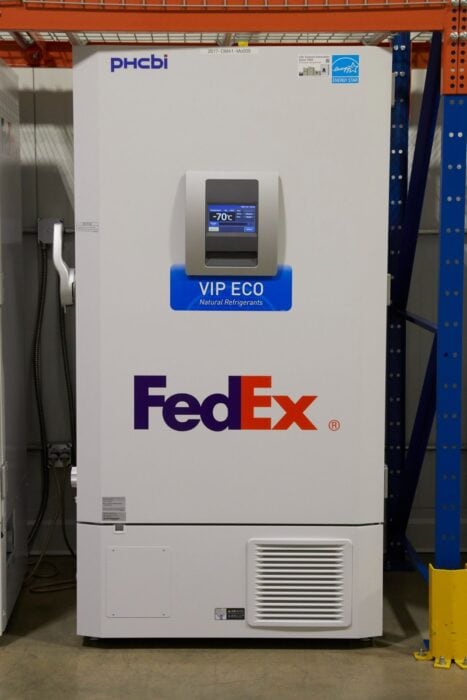Temperature-Controlled Shipping: Definition, Methods, and Limitations

Temperature-controlled shipping is essential for transporting goods requiring specific temperature ranges to maintain quality, safety, and efficacy.
As global commerce grows, there’s an increasing need for reliable temperature-controlled freight transportation methods. Temperature-sensitive pharmaceuticals, perishable foods, or live animals must reach their final destination safely.
Recent studies indicate that improper shipping conditions, mainly certain temperature changes, can adversely impact the quality of goods, leading to significant financial losses and potentially posing health risks.
Temperature-Controlled Transport: Hot and Cold
Temperature-controlled sensitive shipments are essential when transporting goods requiring extreme temperatures. Different products require varying temperature ranges and cold storage conditions. For instance:
- Pharmaceuticals: Many medicines and lab kits require a specific temperature range to maintain efficacy and safety. Any deviations can render this temperature-sensitive cargo ineffective or even hazardous.
- Fresh and Frozen Foods: Items such as fresh fruits, baked goods, and frozen shipments of meat or fish must be kept at the right temperature to prevent spoilage or contamination.
- Livestock: Transporting live animals, whether seafood, farm animals, or insects, demands specialized temperature-controlled environments to ensure their well-being.
Seasonal temperature fluctuation complicates the shipping process. Shipping climate-sensitive items like chocolate during summer requires cooling precautions. Air cargo and ground service transporting goods with reefer trucks or temperature-controlled air freight must follow proper shipping or compromise product quality, causing financial losses and legal repercussions. These fleets require ports like temperature-controlled docks for keeping cargo refrigerated.
Temperature-Controlled Shipping Methods

The nature of temperature-sensitive shipping methods caters to diverse situations. Here’s a brief overview:
- Dry Ice: Used for shipping frozen shipments, dry ice can keep products at sub-zero temperatures.
- Frozen and Recyclable Gel Packs: Effective for maintaining a cold environment, especially for perishable freight like food items.
- Coolers: Provide a controlled environment for temperature-sensitive products during transportation, ensuring the temperature remains within the desired range.
- Refrigerated, Air Cargo, Trucks, and Warehouse Facilities: These are essential for cold chain logistics, offering a controlled environment throughout the supply chain.
- Heaters and Thermal Blankets: Used for goods that need to be kept warm, these tools ensure the products don’t fall below their necessary temperature.
Temperature-Sensitive or Ambient Cargo: Live Animals
The logistics of shipping live animals are intricate, as each species requires specific temperature and humidity ranges. For example, transporting tropical fish and pets and shipping live farmstock demands carried temperature and ventilation controls.
Moreover, there are stringent global regulations governing the shipment of live animals. Agencies like the FDA and IATA set guidelines that cover proper documentation, the quality of the shipping container, adequate food and water, and maintaining a specific climate throughout the journey.
Failure to adhere to these regulations leads to penalties, shipment disruptions, and even a loss of life. Hence, having extensive knowledge of temperature-controlled freight shipping is paramount for logistics solutions providers dealing with sensitive shipments.
Temperature-Sensitive Cargo: Pharmaceuticals
Transporting temperature-sensitive goods like pharmaceuticals is a critical task. Products ranging from life-saving drugs to advanced medical devices have stringent temperature and humidity ranges.
The slightest deviation in the storage conditions can compromise the quality of these products. The FDA provides comprehensive guidelines on the shipment of pharmaceuticals, emphasizing the importance of maintaining specific temperature ranges, adequate documentation, and ensuring the product’s integrity till the final destination.
On the other hand, IATA provides guidelines for air transportation of pharmaceuticals, ensuring they meet optimal shipping conditions. This includes using temperature-controlled cargo facilities and specialized containers that maintain consistent temperatures.
Temperature controlled: Refrigerated or Frozen Shipping

Shipping fresh or frozen goods such as meats, fish, dairy, produce, and flowers demands meticulous planning and execution. These perishable goods have a limited shelf life, and their quality can quickly degrade.
For instance, fresh produce like fruits and vegetables might require a different temperature setting than frozen fish or meat. The FDA and IATA have set regulations for transporting these goods, ensuring they remain fresh and safe for consumption.
Refrigerated trucks and air or train temperature-controlled cargo maintain an uninterrupted cold chain. Special packaging and cold packs or dry ice are necessary until the product reaches its destination.
Temperature Guidelines and Cold Storage Limitations
Temperature guidelines for cold storage are pivotal in ensuring product quality and safety. These guidelines specify the exact temperature and humidity ranges for specific products.
There are inherent limitations, as not all storage facilities can maintain the same temperature range, especially during transit. Limited refrigerated units or disruptions in the cold chain can compromise the product’s quality. Additionally, special packaging that maintains the correct temperature for specific goods is paramount.
Packing aids like thermal blankets, coolers, or gel packs require rigorous testing to ensure they can withstand varying external temperatures and other factors like handling or transit delays.
Tips on Selecting a Refrigerated Shipping Company
Choosing the right refrigerated shipping company is a game changer when transporting temperature-sensitive items. Here are some things to consider:
- Extensive Knowledge and Experience: The company should have an outstanding record with shipping temperature-sensitive goods, cold chain logistics, and handling temperature-sensitive products.
- Compliance With Regulations: Ensure the company adheres to global regulations set by the FDA and IATA. Inadequate documentation or non-compliance can lead to shipment disruptions.
- State-of-the-Art Equipment: The company must invest in top-notch cold chain equipment, from reefer trucks to warehouse refrigeration systems.
- Transparent Tracking System: The ability to monitor the temperature inside the shipment in real-time and alert the shipper about issues.
- Reputation and Reviews: Look for companies with positive reviews, especially from businesses that ship similar temperature-sensitive goods. Their experience can give you insights into the company’s reliability and quality of service.
FAQs
Explore the frequently asked questions about temperature-controlled shipping to clarify the topic.
What is a temperature-controlled shipping package?
The package maintains specific temperature ranges during the transit of temperature-sensitive products.
Are FedEx shipments temperature-controlled?
Yes, FedEx offers temperature-controlled shipping solutions for sensitive shipments.
Does UPS have temperature control?
Yes, UPS provides temperature-controlled transportation services for perishable and sensitive items.
What is FedEx’s temperature-controlled wine shipping program?
FedEx’s program offers specialized wine shipping solutions, ensuring optimal temperature and safe transit for wine products.
Final Thoughts on Temperature-Controlled Freight
Temperature-controlled cargo is pivotal in the supply chain. Temperature-sensitive products must maintain quality and safety from source to final destination. As consumer demand for fresh foods, pharmaceuticals, and other temperature-sensitive goods grows, so does the need for specialized temperature-controlled shipping logistics solutions.
